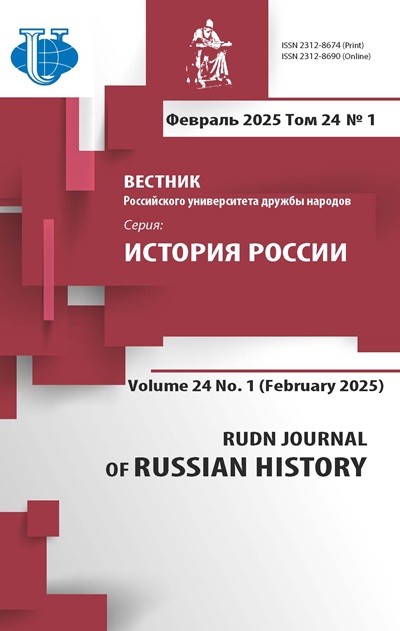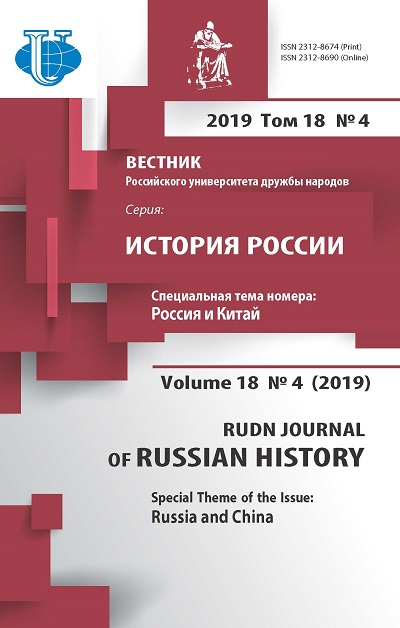Joseph Stalin and the development of Tank Forces of the Red Army in the 1930’s - early 1940’s
- Authors: Kilichenkov A.A.1
-
Affiliations:
- Russian State University for the Humanities
- Issue: Vol 18, No 4 (2019): RUSSIA AND CHINA
- Pages: 962-984
- Section: ARTICLES
- URL: https://journals.rudn.ru/russian-history/article/view/22316
- DOI: https://doi.org/10.22363/2312-8674-2019-18-4-962-984
Cite item
Full text / tables, figures
Abstract
The author attempts to analyze the totality of ideas and opinions of I.V. Stalin on the development of tank weapons in the 1930s. Documents of RGASPI and RGVA archives were used as the sources. Influenced by a series of ‘military alarms,’ Stalin began to closely engage with issues of tank construction in the late 1920s, and initiated a large-scale program for equipping the Red Army with tanks. The program was to ensure the military-technical superiority of the USSR over its likely opponents, with the goal to compensate for the overall backlog. As the USSR was unable to create its own modern tanks, in 1930 the Soviet leadership purchased several dozen military vehicles abroad. Stalin personally controlled the procurement process, often intervening in the process; he also attended demonstrations of tests vehicles and decided on the number of tanks that were to be produced. At the same time he closely followed the technical innovations in foreign armies. The study of Stalin’s interest in tanks reveals that in the early 1930s, the Soviet leader thought of the tank weapon as an ‘asymmetrical alternative’ to overcome the broader gap in preparation for war. The present article analyses how Stalin read the documents that were sent to him; this analysis demonstrates that Stalin was more likely to seek confirmation for his existing views than to actually use the documents for coming to new conclusions. In general, Stalin’s ideas and opinions on tank issues were based on political, economic and logical considerations rather than on military expertise. One case in point is his support for M.N. Tukhachevskii when the latter called for the massive production of surrogate tanks based on tractors. In the mid-1930s, when the army had already received thousands of new tanks, Stalin shifted his emphasis from issues of equipment to the quality of the personnel, while at the same time demanding a simplification of machinery down to the level of a ‘crewman with skills that are just medium or even lower.’ But on the eve of the war, the Soviet leader again returned to the need for a qualitative and numerical growth of armored forces. Finally, Stalin analysed how tank forces were used during the Winter War against Finland and in the first years of war in Europe, but he remained unable to assess the strike potential of this weapon and its role in the future war with Nazi Germany.
About the authors
Aleksei A. Kilichenkov
Russian State University for the Humanities
Author for correspondence.
Email: rsuh@rsuh.ru
Doktor istoricheskikh nauk [Dr. habil. hist.], Professor at the Department of Contemporary History of Russia, Russian State University for the Humanities.
6, Miusskaya Sq., Moscow, 125993, RussiaReferences
- Brereton, John M. Russian tanks: evolution and development, 1915–1968. Berkeley: Feist Publications Publ., 1970.
- Bystrova, I.V. Sovetskiy voyenno-promyshlennyy kompleks: problemy stanovleniya i razvitiya (1930–1980-ye gody). Moscow: IRI RAN Publ., 2006 (in Russian).
- Dimitrov, G.M. “1940 g. 7 noyabrya. Iz dnevnika.” In V.A. Nevezhin. Stalin o voyne. Zastol’nyye rechi 1933–1945 gg., 118–119. Moscow: Yauza Publ., 2007 (in Russian).
- Fleischer, Wolfgang. Russian tanks and armored fighting vehicles, 1917–1945: an illustrated reference. Atglen: Schiffer, 1999.
- Gavrilov, V.A. “Kanun voyny: rokovyye proschety.” MGIMO Review of International Relations, no. 2 (2011): 109–117 (in Russian).
- Golubev, A.V. “Sovetskoye obshchestvo i «voyennyye trevogi» 1920-kh gg.” Otechestvennaya istoriya, no. 1 (2008): 36–58 (in Russian).
- Harris, J.P. Men, Ideas and Tanks: British Military Thought and Armoured Forces, 1903–1939. Manchester: Manchester University Press Publ., 1995.
- Hofmann, George F. “Doctrine, Tank Technology, and Execution: I.A. Khalepskii and the Red Army’s Fulfillment of Deep Offensive.” The Journal of Slavic Military Studies 9, no. 2 (1996): 283–334.
- Hofmann, George F. A “Yankee Inventor and the Military Establishment: The Christie Tank Controversy.” Military Affairs 39, no. 1 (1975): 12–18.
- Hofmann, George F. “The United States’ Contribution to Soviet Tank Technology.” Journal of the RUSI 125, no. 1 (1980): 63–68.
- Ken, O.N. Mobilizatsionnoye planirovaniye i politicheskiye resheniya (konets 1920 – seredina 1930-kh godov). Moscow: OGI Publ., 2008 (in Russian).
- Kilichenkov, A.A. “Tanki konstruktsii Dzh. Kristi i ikh sud’ba v SSHA i SSSR (1930-ye gody).” Novyy istoricheskiy vestnik, no. 2 (2018): 139–154 (in Russian).
- Kolomiyets, M.V. Sovetskiy sredniy tank T-34. Luchshiy tank Vtoroy mirovoy voyny. Moscow: Eksmo; Yauza Publ., 2017 (in Russian).
- Kolomiyets, M.V. Sovetskiy tyazhelyy tank KV-1. Pervyye tanki Pobedy. Moscow: Eksmo; Yauza Publ., 2017 (in Russian).
- Kul’kov, Ye. Zimnyaya voyna 1939–1940. Kniga vtoraya. I.V. Stalin i finskaya kampaniya. (Stenogramma soveshchaniya pri TSK VKP (b)). Moscow: Nauka Publ., 1999 (in Russian).
- Malyshev, V.A. “Proydet desyatok let, i eti vstrechi ne vosstanovish’ uzhe v pamyati.” Istochnik, no. 5 (1997): 110–120 (in Russian).
- Shepova, N.Ya. “Byl li gotov SSSR k vedeniyu Velikoy Otechestvennoy voyny?” MGIMO Review of International Relations, no. 2 (2011): 96–108 (in Russian).
- Solyankin, A.G. Otechestvennyye bronirovannyye mashiny. XX vek. Vol. 1. Moscow: OOO Izdatel’skiy tsentr “Eksprint” Publ., 2002 (in Russian).
- Solyankin, A.G., Pavlov, M.V., Pavlov, I.V., and Zheltov, I.G. Otechestvennyye bronirovannyye mashiny. XX vek. Otechestvennyye bronirovannyye mashiny. 1905–1941 gg. Moscow: Eksprint Publ., 2002 (in Russian).
- Sokolov, A.K. Ot voyenproma k VPK: sovetskaya voyennaya promyshlennost’. 1917 – iyun’ 1941 gg. Moscow: Novyy khronograf Publ., 2012 (in Russian).
- Simonov, N.S. Voyenno-promyshlennyy kompleks SSSR v 1920–1950-ye gody: tempy ekonomicheskogo rosta, struktura, organizatsiya proizvodstva i upravleniye. Moscow: ROSSPEN Publ., 1996 (in Russian).
- Stalin, I.V. “Rech’ na priyeme 4 maya 1935 g. (nepravlenaya stenogramma).” V.A. Nevezhin. Stalin o voyne. Zastol’nyye rechi 1933–1945 gg., 55–56. Moscow: Yauza; Eksmo Publ., 2007 (in Russian).
- Stalin, I.V. “Kratkaya zapis’ vystupleniya na vypuske slushateley akademiy Krasnoy Armii. 5 maya 1941 goda.” I.V. Stalin. Sochineniya. Vol. 18, 213–220. Tver’: Soyuz Publ., 2006 (in Russian).
- Svirin, M.N. Bronya krepka. Istoriya sovetskogo tanka. 1919–1937. Moscow: Yauza; Eksmo Publ., 2005 (in Russian).
- Vasil’yev, V.V. “I.V. Stalin: ‘Nam krayne vazhno imet’ chertezhi etogo tanka...’ Vklad sovetskoy voyennoy razvedki v razvitiye otechestvennogo tankostroyeniya.” Military Historical Journal, no. 5 (2016): 46–51 (in Russian).
- Vlakancic, Peter J. “Marshal Tukhachevsky and the ‘Deep Battle:’ An Analysis of Operational Level Soviet Tank and Mechanized Doctrine, 1935–1945.” The Land Warfare Papers, no. 14 (1992): 1–34.
- Zaloga, Steve, and Grandsen, James. Soviet tanks and combat vehicles of World War Two. London: Arms and Armour Press Publ., 1984.
- Zheltov, I.G., Pavlov, I.V., and Pavlov, M.V. Tanki BT. Moscow: Eksprint Publ., 2001 (in Russian).
- Yermolov, A.Yu. Gosudarstvennoye upravleniye voyennoy promyshlennost’yu v 1940-ye gg.: tankovaya promyshlennost’. St. Petersburg: Aleteyya Publ., 2013 (in Russian).
















